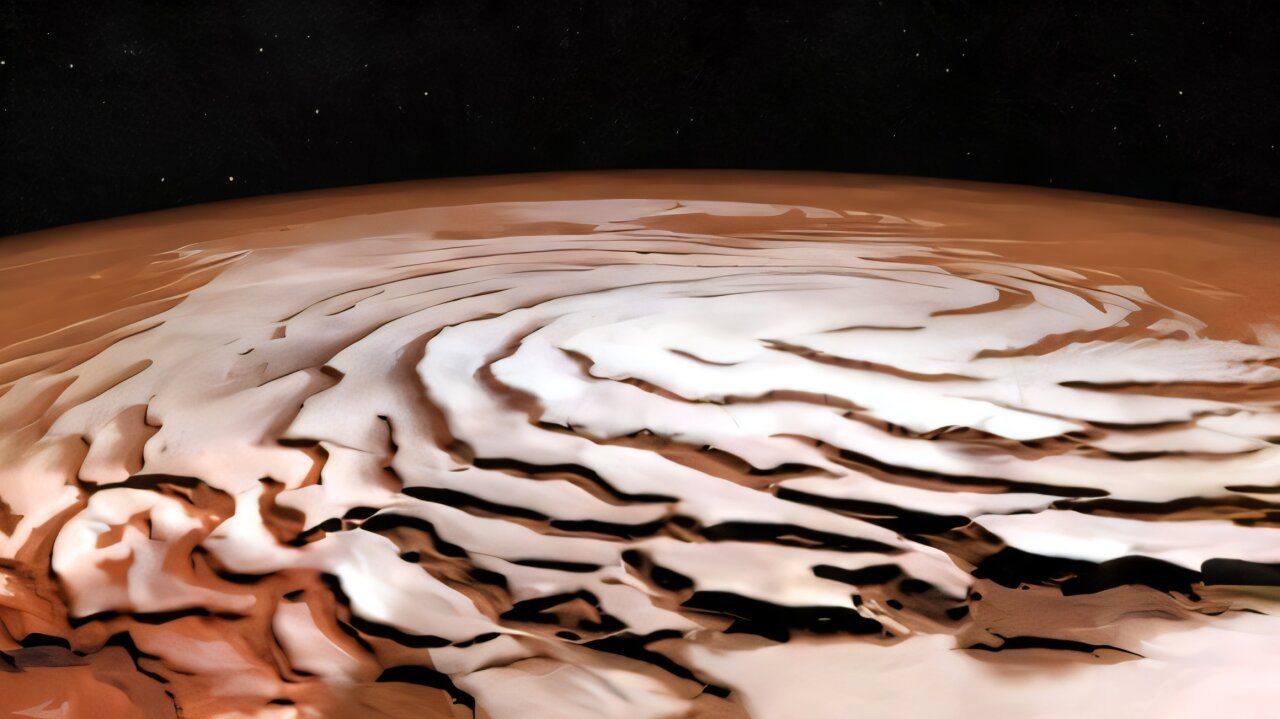Planetary scientists have investigated how Mars’ northern ice cap affects the local topography and through this have learned the rate of growth. This made it possible to reveal the age of the glaciers. They turned out to be unexpectedly young.

Mars’ northern ice cap
If you’ve ever looked at Mars through a telescope, you’ve probably noticed its two polar ice caps. The North is composed mostly of water ice, the most obvious sign that the planet was once a wetter, warmer world. A team of researchers from the German Aerospace Center (DLR) used this ice cap to make surprising discoveries about it and what it can tell us about the inner world of Mars. The results of the study were published in the journal Nature.
According to Adrien Broquet and a team of DLR planetologists, the north polar cap on Mars is quite young. They found this out by applying the methods used to measure the effect of ice sheets on the Earth on its surface. The effect that leads to widespread glaciation is called “glacial isostatic adjustment,” and it still occurs in places like Scandinavia. It is essentially a permanent land movement where the earth’s surface deforms in response to the weight of the ice. The rate of deformation depends on the specific characteristics of the underlying mantle.
Large areas of our planet have been covered by thick ice sheets from time to time. The last time this happened was during the Ice Age, which ended about 11,700 years ago. These layers “weighted” the surface by compressing it. When the glaciers melted, the surface began to rise back up in a process called “isostatic rebound.” The speed of both the sinking and subsequent rise indicates somewhat about the Earth’s interior, particularly the mantle. Imagine that you press down on the sponge and then watch it expand when you remove your hand.
Isostatic rebound
Broquet and his team decided to measure the isostatic rebound of a glacier on Mars beneath the northern ice cap. It is about 1,000 kilometers wide and 3 kilometers thick. They studied its formation by combining models of the planet’s thermal evolution with calculations of the glacier’s isostatic rebound, as well as gravity, radar and seismic observations.
The team concluded that Mars’ north polar cap is young enough that it is pressing down on the soil beneath it. “We have shown that the ice sheet pushes the underlying soil into the mantle at a rate of up to 0.13 millimeters per year,” Broquet said. According to team member Ana-Catalina Plesa, it’s a fairly minor deformation.
Understanding planetary structure
How can measurements of the ice burdening the planets’ surfaces tell us so much? Remember that rocky planets like Earth and Mars are in a state of constant change. These changes can range from short-term events such as volcanic eruptions to long-term events such as ice ages. Each change affects the surface, and the rate at which the surface deforms and bounces back. Earth scientists use techniques such as studying the isostatic alignment of glaciers to dive deep beneath the surface and understand the characteristics of these layers.
When ice presses on the surface, the size of the depression depends on the viscosity of the mantle. It is a measure of how strongly the rocky materials of the mantle resist flow. Rocks in the Earth’s mantle are more than a trillion times more viscous than asphalt. However, they still deform and flow over geologic periods of millions of years.
Using radar data and other techniques to study the rate at which the Earth’s surface sinks and rises, scientists can detect the viscosity of the mantle. It turns out that if the same methods are applied to Mars, it provides some surprises, particularly the seemingly cold north pole and the recently volcanically active equatorial regions.
Determining the age of Mars’ ice cap
To understand why Mars’ interior is the way it is, we need estimates of Mars’ gravity field (variable), seismic measurements made by the InSight lander, and other data. All of them help to determine the rate of sinking and rising of the surface and interior of the Red Planet. What’s the result? It turns out that the surface beneath Mars’ north pole has not had time to fully deform under the weight of the ice.
Broquet’s team estimates that the surface area of Mars’ north pole is now subsiding at a rate of up to 0.13 millimeters per year. If it happens so slowly, the viscosity of the upper mantle indicates that the Martian interior is quite cold.
The team’s measurements indicate that the icy young cap is much larger than any other large-scale feature observed on the planet. It’s probably between 2 and 12 million years old.
Other places on the planet may not be as cold as the polar regions. “Although the mantle beneath Mars’ north pole is considered cold, our models are still able to envision localized melting zones in the mantle near the equator,” says study co-author Doris Breuer.
These results are the first time scientists have discovered glacial isostatic regulation operating on another rocky planet. Upcoming missions to Mars may include more instruments to measure the rise and fall of the Martian surface in response to glaciation.
According to phys.org


